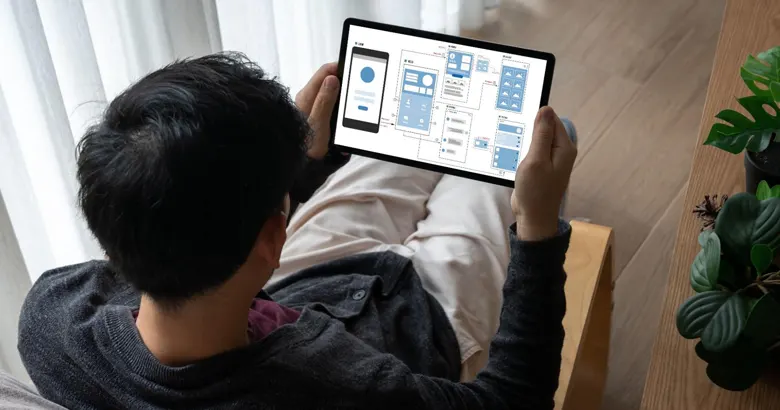Find out all the information you need on UI development salaries, high-paying industries, the job market, and how to land your first position.
If you’re wondering how much you might earn as a UI developer then you’re in the right place. In this complete guide to UI developer salaries, we’ll be briefing you in detail on the earnings of UI developers across the world, the job market and demand for UI development skills, the industries that pay the highest salaries, and how to land a job in UI development. In addition, we’ll be offering you tips and tricks for your salary negotiation, outlining similar roles in the field, and guiding you on the different factors that might impact your salary offer.
By the end, you’ll be well-informed on the pay you should expect for your level of expertise and location and nail your next UI developer salary negotiation.
Contents:
- UI developer job market and demand
- What is the current demand for UI developers in India?
- UI developer salaries around the world, from junior to senior
- Industries with the highest UI developer salaries
- Factors that can impact a UI developer’s salary
- How to handle your UI developer’s salary negotiation
- Different roles within the UI development space
- How to land a job in UI development
- Conclusion
Ready to learn more? Then let’s jump in!
1. UI developer job market and demand
A UI developer combines the skills of UI design and front-end development to design and code user-centred digital interfaces. Due to their combined experience in programming, user psychology, and design, UI developers can create seamless and delightful digital experiences that attract users, build trust and loyalty in a brand, and encourage repeat visits and purchases. This role not only has the scope to provide significant job satisfaction and career longevity but is also a position that employers are increasingly seeking to fill.
This is because,
Thanks to the unique combination of design, coding, and user research skills that the UI developer embodies, the employment outlook for the role is very positive. Demand from employers is expected to grow considerably over the next decade as recognition of the user experience and its impact continues to become more widely acknowledged. Statistics by the US Bureau of Labor Statistics predict growth in the UI development job market to increase by an impressive 8% between 2020 and 2029, well above the average for most occupations.
2. What is the current demand for UI developers in India?
India’s digital economy is exploding right now, with the sector expected to be worth a staggering $800 billion by 2030. Tech companies are catering to more than 658.0 million internet users in the country, which is pushing up demand for talented developers and designers who can create seamless digital experiences and support companies in staying ahead of digital trends.
The COVID-19 pandemic is also cited as a reason for the acceleration in user demand for digital experiences in the country. Users are spending more time online than ever before thanks to the remote and flexible working opportunities that the pandemic brought about. With the rapid acceleration in demand for digital experiences, those with UI and front-end development skills are among the most sought-after professionals by businesses in India today, with the job market for developers of all kinds expected to experience a steady growth rate of 23 percent between 2021 and 2031.

3. UI developer salaries around the world, from junior to senior
Curious to know about entry-level, mid-level, and senior-level UI developer salaries in your country? Take a look at our table to find out how much you might expect to earn in this role across the globe.
|
Entry-level UI developer |
Mid-level UI developer |
Senior UI developer |
|---|---|---|---|
|
Brazil |
R$28,000 |
R$146,748 |
R$288,000 |
|
Canada |
$63,000 |
$82,492 |
$97,000 |
|
China |
¥249,299 |
¥346,346 |
¥433,069 |
|
France |
€49,495 |
€69,543 |
€85,980 |
|
Germany |
€45,000 |
€54,756 |
€62,000 |
|
India |
₹ 8,69,513 |
₹ 22,65,156 |
₹ 36,60,799 |
|
South Africa |
R 480, 000 |
R 720,000 |
R 8,400,400 |
|
United Kingdom |
£34,000 |
£50,000 |
£75,000 |
|
United States |
$100,000 |
$114,265 |
$130,000 |
Sources: Glassdoor UK, Glassdoor India, UK.Talent, ZipRecruiter, ZA Talent, PayScale, SalaryExpert, Glassdoor Canada
4. Industries with the highest UI developer salaries
As might be expected, tech and software companies offer high starting salaries to UI developers. Businesses in this sector require the skills of UI developers to build intuitive interfaces on their apps and websites which bring about seamless and enjoyable experiences for their users. While tech startups tend to offer employees the opportunity for more creativity and innovation, corporate companies in this sector typically offer more job stability as well as access to more resources and assistance.
The finance industry is another sector seeking talented UI developers due to the increasing digitization of financial products and services. In this sector, UI developers are typically responsible for designing and implementing user-centred interfaces for financial products and services that support users in areas such as financial transactions, account management, and interactions with customer support agents while simultaneously ensuring the security and ease of use of the software. In this industry, it is particularly important that the UI developer is both aware of and adheres to all legal and regulatory restrictions connected to financial services, data protection law, and user privacy.
With more users shopping online than ever before, the design and implementation of seamless user interfaces for e-commerce apps and websites can define a company’s success in the sector. A UI developer working in the e-commerce industry is typically responsible for designing and coding visually compelling, easy-to-navigate, frictionless online shopping environments that support brand engagement, encourage registration and purchases, and lead to positive testimonials and repeat customers.
Gaming is another sector in which UI developers are increasingly sought with the role’s responsibilities including performing and analysing large-scale A/B tests, designing and building UI interfaces and systems, and writing automated tests to uphold game quality–all to bring interactive gaming experiences to life. Candidates for UI development roles in the gaming industry are usually required to have solid front-end programming skills and a prototype mentality.
5. Factors that can impact a UI developer’s salary
When applying for a UI developer position, an employer will always take your experience level into serious consideration when offering you a salary. While a junior UI developer in the UK might expect to earn on average £34,000 with one or two years’ experience in the role, a senior UI developer with eight or nine years’ experience can expect to be offered something closer to £75,000. For this reason, and to avoid disappointment, it’s important to apply for positions that directly request the level of experience you have to offer. The importance of building up hands-on experience in the field cannot be understated; the wider your range of skills and the deeper your level of knowledge, the higher your chances are of a more substantial pay reward.
Aside from your years of experience as a UI developer, your qualifications will play a significant role in the calculation of your yearly remuneration. Be sure to highlight any specialist training, one-off courses, relevant classes, or degree programs you have studied along with supporting documentation or certification, including the grade you came away with. This information will not only show an employer how committed you are to the field of UI development, but will also give them a good idea of where your areas of interest lie, any knowledge gaps you might have, what further training might be required, and how advanced your theoretical knowledge of the field is. With this information, an employer can make a more rounded assessment of how much they are willing to pay you, as well as decide if they are willing to invest in any additional education you might need.
Finally, your location will play a role in the salary you might be offered by a potential employer due to variations in cost of living. Jobs based in cities tend to come with higher salaries to make up for the higher expenses associated with city living, while positions in rural areas typically come with lower salaries to reflect the lower cost of living in those areas. The economic conditions of different regions and countries will also impact salary levels in those areas, as will the varying demand from region to region for specific skills. We recommend this cost of living calculator to help you work out your living expenses wherever in the world you are applying for positions so you can see if the salary you are offered enables you to maintain or improve on your current lifestyle.
6. How to handle your UI developer salary negotiation
When preparing for a job interview or salary negotiation for a UI developer role, it’s important to do your research. As we’ve mentioned, having a good understanding of the cost of living in your area will be important, but equally so is having knowledge of local salaries for the same or similar roles. Take a look on job boards such as Monster, Indeed, or LinkedIn, or check out salary comparison websites such as Glassdoor, PayScale, and Salary.com to get a feel for what UI developers of your experience and education level are earning in companies of a similar size to the one you are applying for. If you have connections in the industry, you may also ask them for advice on what salary to expect.
Once you’ve done your research, you’ll want to come up with a specific figure to ask for in your salary negotiation. Studies have shown that the more specific your request, the higher your chances of success will be in terms of being offered that salary. The reason for specificity here is that it demonstrates you are well-informed and have done your research. This is not just impressive to potential employers, it also shows that they are not in a strong position to offer you less than you deserve.

7. Different roles within the UI development space
Curious about other roles that work alongside UI developers? Let’s take a look at the roles and responsibilities of the UI designer, UX designer, front-end developer, and interaction designer.
i. UI designer
A UI designer seeks to create intuitive and appealing interfaces for digital products such as websites and apps with a sharp focus on the user’s experience and their ability to meet their goals. Often working in collaboration with UX designers and developers, the UI designer creates digital layouts using techniques such as wireframing and prototyping before performing extensive testing with users. Based on feedback from users and stakeholders, the UI designer iterates on and refines their designs before handing them over to the development team for implementation. UI designers work with UI developers by providing them with specific design specifications, resources, and relevant data to enable the implementation of the design in code. Additionally, the two roles maintain communication throughout the design process to ensure the implemented interface aligns with both the design team’s vision and all user experience goals.
ii. UX designer
A UX designer is concerned with understanding the user’s needs, goals, behaviours, and preferences relating to a digital product or service to be able to design and curate seamless and satisfying experiences for them. By utilising research, prototyping, wireframing, and testing techniques, the UX designer seeks to optimise every element of the user’s journey through an interface to improve the user’s experience and enhance the overall usability of the product. UX designers collaborate with UI developers by providing them with the design materials and resources they need to ensure the prioritisation of usability in the final interface. This includes handing over wireframes, user flows, and design guidelines.
iii. Frontend developer
Through the use of programming languages such as HTML, CSS, and JavaScript, a front-end developer is responsible for the implementation of the user interface and its interactive elements for websites and apps. Working closely with the design team, the frontend developer brings to life the designs and functionalities of the user-facing part of the product and ensures these components are responsive, user-centred, and visually engaging. Working with the UI developer, the frontend developer implements the user interface design using functional code, together creating websites and apps that are responsive and accessible to all users.
iv. Interaction designer
An interaction designer is concerned with the point at which humans and digital products meet and interact. They analyse design flows, the needs of users, and interactive design elements to create a seamless experience, incorporating usability, accessibility, and human-computer interaction principles into their practice. Interaction designers hand over detailed interaction specifications and prototypes to UI developers to create engaging experiences and build interfaces which effectively communicate with users.
8. How to land a job in UI development
Let’s take a look at the steps you need to take to secure your first UI development position–from performing research into the field to taking an accredited UI development course.
i. Research
Performing extensive research will be your first step in the process of landing a job in UI development. From reading blogs and books, to listening to podcasts or watching online tutorials, spending time learning the principles, trends, and best practices of UI development will help you decide if this is the right career for you and provide you with the foundational industry knowledge you need to support your transition to a more formal course of learning later on. As well as getting to know tips and trends, researching the field can help you stay up to date on the tools and software commonly used by UI developers, and get a feel for the job market, too.
ii. Education and training
Those interested in becoming UI developers will need to undertake a formal course of education in order to acquire the design and programming skills required to perform the role successfully. A course in UI development with an online program, a college course, or a university degree will ensure that, in addition to design and programming skills, a student comes away with in-depth knowledge of the latest tools and software, a professional portfolio, and a network of alumni–all valuable assets when it comes to finding a job. While it may be possible to learn UI development skills alone, we’d highly recommend embarking on a program of structured learning to ensure you have the knowledge required to work as a professional in the field.
iii. Portfolio creation
Whether you're learning alone or as part of a taught UI development program, creating a professional portfolio of your projects is an essential step on your journey to landing a position in this creative and rewarding field. Your UI development portfolio is an opportunity for you to demonstrate your work processes, projects, range of skills, and any specialisations as well as highlight your creative flair and problem-solving skills to potential employers. An effective way of presenting your UI development portfolio is on a project-by-project basis.
For each project, consider including:
- The user and business goals;
- Challenges which needed to be overcome;
- Your work process at each stage of design and implementation (Eg; research, wireframes and sketches, feedback rounds, programming, user testing);
- The tools you used;
- Screenshots of the final results.
By including each of these details, your potential employer will be able to form a clear idea of how you work, what's important to you, how well you collaborate, and how you measure success.
iv. Work experience
While training and education are crucial to building the foundations of your knowledge in UI development, hands-on work experience will be key to cementing that knowledge in real world settings and honing your skills. To gain work experience, consider volunteering for charity organisations or offering to work on an interface design for a friend or family member’s website. If you feel ready, you may also want to apply for one-off freelance opportunities. Once completed, you can include these projects in your portfolio and demonstrate to employers your ability to apply the principles of the practice to real UI projects. If you have a portfolio website or a profile on a professional networking site such as LinkedIn, you could collect testimonials from satisfied customers and publish them there too.
v. Networking
Whether online or in-person, professional networking will be an important stepping stone to making the valuable industry connections that could lead you to your first position. By networking with other design and development professionals, you’re likely to hear of job vacancies, internships, or freelance opportunities. This is your chance to make a positive first impression on those working in your industry and be sure you’re the person they think of when they hear of a relevant UI development opportunity.
There are numerous ways you can network both on and offline. Attending panel discussions in your area, signing up for online webinars, or going to casual meetups for freelance developers and designers, are all effective ways of meeting other UI developers as well as team leads, project managers, and even CEOs looking for new talent. If you’re not sure where to start, check out these websites and apps for online and offline networking opportunities: MeetUp, EventBrite, StartUpNation, BNI, Behance, AngelList, and GitHub.

vi. Jobs boards
When you’re ready to start applying for your first UI development positions, general and specialised job boards will help you narrow down your search. Here are our recommendations.
a. General jobs boards
b. Design and development job boards
For a detailed guide to cracking UI developer interviews, here’s a blog you can read: 21 UI Developer Interview Questions (and How To Answer Them)
Conclusion
In this article, we’ve run through the job market and salaries for UI developers across the globe and provided clear steps to follow to find your first position in the field.
To reiterate, thoroughly research salaries in your area for UI developers (or similar positions) when you are preparing for a job interview. This will give you a good indication of what you should expect to be offered and leave you in a stronger negotiation position.
If you’d like to learn more about UI development, head back to the AND Academy blog for more articles like this one.
Here are some specific action points:
- Watch this session by Shiva Viswanathan, Design Head of Ogilvy Pennywise, and Naman Singh, Product Experience Designer at RED.
- Talk to a course advisor to discuss how you can transform your career with one of our courses.
- Pursue our UX UI Design courses - all courses are taught through live, interactive classes by industry experts, and some even offer a Job Guarantee.
- Take advantage of our scholarship and funding options to overcome any financial hurdle on the path of your career transformation.
Note: All information and/or data from external sources is believed to be accurate as of the date of publication.










